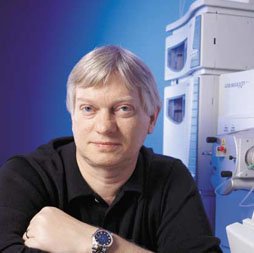离子阱技术发明人Stafford离开Thermo转投Agilent
上一篇 / 下一篇 2009-11-20 09:47:49/ 个人分类:液质联用
Profile: George C. Stafford, Jr.
By Harish Padmanabhan, Thermo Fisher Scientific
| Currently | Director of Research, Finnigan Mass Spectrometry, Thermo Fisher Scientific |
| Patents & Publications | Has over 40 publications and issued patents in the field of Mass Spectrometry |
| Education |
September 1973 – May 1977 University of Virginia, Charlottesville, VA, Ph.D. Chemistry September 1969 – May 1973 Virginia Commonwealth University,Richmond, Virginia, B.S. Chemistry |
| Professional Societies |
American Chemical Society American Society for Mass Spectrometry Bay Area Mass Spectrometry 1995-1996 Chair Elect 1996-1997 Chairperson 1997-1998 Immediate Past Chairperson |
| Awards |
2001 ASMS Award for Distinguished Contribution in Mass Spectrometry for the invention of the ion trap mass-selective ejection scan. Anachem Award presented by the Association of Analytical Chemists at the FACSS Meeting in Cincinnati, Ohio, October 1995. This award was given for the invention of the conversion dynode electron multiplier negative ion detector and for development of ion trap technology |
Part 1: George Stafford’s early years in Mass Spectrometry
During 1973, as an undergraduate student at Virginia Commonwealth University(Richmond, Virginia), George C. Stafford, Jr. was working on his final year project trying to determine the structure of an unknown compound produced by a photosynthetic reaction. Fascinated by instrumentation at an early age, Stafford was considering adopting nuclear magnetic resonance (NMR) spectroscopy as his field of research. However, NMR did not provide the complete answer Stafford was looking for. Without finding the mass of the compound, he could not make much progress in determining the structure of the compound.
After graduating with a B.S. degree in Chemistry, Stafford was admitted to the Ph.D. program at the University of Virginia (Charlottesville, Virginia). Under the guidance of Professor Donald F. Hunt, he decided to use mass spectrometry in addition to NMR to decipher the unknowns in the field of Chemistry. Meeting Professor Hunt was the first turning point in his career.
Professor Hunt was a positive influence on Stafford during this period. He instilled inStafford the importance and excitement of discovering new things. Inquisitive to figure out and use the fundamental property of mass, Stafford decided to take the plunge into Mass Spectrometry. Professor Hunt had convinced him that mass spectrometry was a powerful tool and that it could perform. a variety of analyses. In addition, the interdisciplinary nature of Mass Spectrometry that integrated fields ranging from chemistry, physics, electronics, and mechanical engineering design was particularly compelling.
While working in Professor Hunt’s lab, Stafford attended his first American Society for Mass Spectrometry (ASMS) conference in Houston during the spring of 1975. This was his first contact with the industry. He used this opportunity to meet with various experts from the industry, several from Finnigan Corporation (now part of Thermo Fisher Scientific).Stafford was impressed by the expertise Finnigan had in inventing and developing new products in the field of mass spectrometry. The company had had a strong relationship with academia and this collaboration played a vital function in many fundamental developments in the field of mass spectrometry. ASMS 1976 in San Diego proved to be the second turning point in his career. Meeting Michael Story who was Director of Research and Product Development at Finnigan was instrumental in this turning point. Story impressed in him the role played by the industry in contributing to the field of mass spectrometry. After graduating with a Ph.D. in Chemistry in 1977, Dr. Stafford joined Finnigan as a research scientist.
Dr. Stafford’s initial work was on developing ion sources and ion detectors for gas chromatography/mass spectrometry. During this time he was responsible for developing new technology and hardware to improve quadrupole mass spectrometry. He was part of the team developing negative ion detection technology, improved chemical ionization and electron ionization hardware for the 4000 single quadrupole mass spectrometer.
Dr. Stafford became interested in ion trap mass spectrometry first during the 1979 ASMS Conference in Seattle, Washington when he attended a talk by Professor Ray March. Returning to Sunnyvale, California, he spent a summer working with John Syka constructing an ion trap mass spectrometer and later first operated the ion trap using the mass selective ejection scan. This scan was the birth of commercial ion trap technology.
Part 2: George Stafford and 25 years of Ion Traps
Innovation has always been the driver of new technology development at Thermo Fisher Scientific. Valuable contributions from several University collaborators helped George Safford convert this core value into significant contributions to the field of ion trap mass spectrometry over the past 25 years.
Dr. Stafford has relied on two ways to discover or invent new technology: first, pursuing an insightful observation leading to the understanding of an inherent principle and this in turn leading to product development; second, manipulating an existing technology or process in different and completely opposite ways and observing its behavior. in an altered state leading to the discovery or invention of a totally new technology. Staffordbelieves that both of these methods have been instrumental in the development of highly sensitive ion trap mass spectrometers over the last 25 years.
During the late seventies Stafford was working on gas chromatography (GC) chemical ionization (CI) mass spectrometry (MS) at Finnigan Corporation (now part of Thermo Scientific). Professor Donald Hunt at the University of Virginia who served as a consultant to the company had previously proposed to him that using negative CI for molecules such as pesticides may help improving detection limits using a mass spectrometer. While working with negative and positive ions, Stafford stumbled upon a key observation. He observed that the electron multiplier detector was able to identify a negative ion generated by the source, even when the detector was actually set to detect positive ions. This occurred to him when the mass spectra suggested to him that it was indeed that of negative ions albeit with a significantly lower intensity. This led to the insight that after the negative ions passed through and were analyzed by the mass filter; a very small fraction of negative ions would be converted into positive ions because of the RF fringe voltages and thus would be detected by the electron multiplier operating in the positive ion mode. By incorporating a dynode operated at a high DC voltage, Stafford observed that the ions could be intentionally accelerated to hit the surface of the dynode at the exit of the mass filter. He further observed that the efficiency of the positive to negative ion conversion improved by at least a thousand fold. This was an instance where keen observation led to new technology development.
Inspired by Ray March’s talk during the 1979 American Society of Mass Spectrometry (ASMS) conference (Seattle, Washington ) and John Todd’s pioneering work in ion traps,Stafford started working on developing ion trap mass spectrometers. Typically a mass spectrometer detected ions that were transmitted or remained stable through the analyzer. During the summer of 1979, Stafford decided to build and test a conventional quadrupole ion trap, but instead tried to operate it in a different or opposite scan method. Rather than detect stably trapped ions in the quadrupole ion trap, he decided to try the opposite and detect ions that became unstable and were ejected from the ion trap. Stafford figured that by trapping all the ions of interest at once and then scanning the device to cause ions to become sequentially unstable in m/z, he would be able to detect all ions with a much higher sensitivity. This was a completely new paradigm at that time and this innovative approach led to the development of the first commercial ion trap mass spectrometer.
The significance of such technologies pertaining to the development of quadrupole ion traps and electron multiplier ion detectors cannot be less emphasized. Fields of study such as Proteomics have been significantly benefited by the development of ion trap technology that lets researchers detect attomol levels of sample.
Stafford ’s research and development group at Thermo is involved in several collaborations with external scientists to further develop mass spectrometry and associated applications. For instance, many developments have been pioneered by Professors Donald Hunt and Graham Cooks (Purdue University) in the areas of tandem mass spectrometry analysis, mass range, mass resolution and proteomics. Professor Cooks has previously worked and continues to work on developing tandem mass analysis on quadrupole ion trap instruments and devising methods to identify and characterize small molecules and proteins. Professor Cooks is also working on atmospheric pressure ionization techniques for improving protein coverage. Other collaborative projects with Professor Cooks include miniaturization of ion trap mass spectrometers and soft landing of ions on surface in order to help characterization of protein substances. Professor Hunt on the other hand is actively working on improving coverage and lowering detection limits on the Thermo Scientific LTQ™. Professor Hunt is also working on Electron Transfer Dissociation (ETD), a new technique which promises to produce more efficient and more complete product ion spectra. ETD in combination with ion traps has the potential to accelerate the use of Top-Down Proteomics.
These last 25 years have been exciting for Life Science research and much is due to tremendous advances in mass spectrometry technology and in specific ion trap technology. Stafford played a key role in this progression from detecting an unstable ion 25 years ago to the development of the modern day ultra sensitive LTQ linear ion trap. It is only mind-boggling what we can expect to see 25 years from now.
相关阅读:
- 有机质谱原理讲义 (snow_white, 2008-12-19)
- 四极杆离子阱飞行时间质谱工作原理动画 (Helen123, 2008-12-21)
- 微滴液相微萃取技术用于气相色谱-质谱法分析药品中的酞酸酯和对羟基苯甲酸酯 (fzdxlfw, 2009-1-05)
- 高效液相色谱2电喷雾离子阱质谱法分析6种氨基糖甙类抗生素 (fzdxlfw, 2009-1-17)
- 一种光电离离子阱质谱仪技术研究 (木偶人6, 2009-4-21)
- LCQ Hardware Troubleshooting (aa_tang, 2009-8-11)
- 质谱沙龙第二十三期活动报道 (hongjingzi, 2009-11-04)
- Bruker推出新一代超高灵敏度离子阱质谱amaZon (release, 2009-5-11)
- amaZon离子阱质谱仪样本 (release, 2009-11-16)
- 老学究:离子阱技术发明人从Thermo跳槽到Agilent (release, 2009-11-19)


